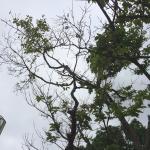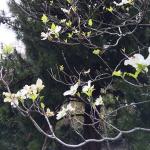A monthly e-newsletter from UMass Extension, published March to October, for home gardeners.
To read the articles in each section of the newsletter, click on the section headings below to expand the content:
Tips of the Month
May is the Month to…..
- Prune spring flowering shrubs. Spring flowering shrubs such as forsythia (Forsythia spp.), rhododendrons and azaleas (Rhododendron spp.), Virginia sweetspire (Itea virginica), mock orange (Philadelphus spp.), ninebark (Physocarpus opulifolius), spring blooming spirea (Spirea prunifolia and S. vanhouttei), lilacs (Syringa spp.) and viburnums (Viburnum spp.) should be pruned after they bloom for maximum flower display. These shrubs form their flower buds in the previous year, on last season’s stem growth. Pruning these shrubs before bloom removes flowers buds and reduces the number of flowers. When pruning deciduous shrubs, follow the principle of thinning and renewal by taking out some of the oldest stems each year. Well pruned shrubs contain stems of various ages.
- Plant cool season crops directly outside. Early May is a good time to sow seeds of cool season crops such as spinach, beets, radish, carrots and lettuce. Seeds are sown thickly in rows and thinned later to the desired spacing to allow them to develop properly. Root crops such as carrots, beets, and radishes are thinned to a 2-inch spacing to allow the roots to develop properly. They are thinned as soon as they reach small edible size. Transplants may be preferred for leafy vegetables such as kale and chard, as they establish faster and mature early.
- Direct sow seeds of summer vegetables. Some summer vegetables such as beans, corn, cantaloupes, okra, zucchini, watermelon, cucumber, squash and pumpkin can be directly sown in the field at the end of May when there is no risk of frost. Soil temperatures should have warmed adequately for seeds to germinate and transplants to grow well. Garden soil temperatures need to be 60⁰ Fahrenheit or higher and warm season crops do best if soil temperatures are above 70⁰F. Direct seeding is not practical for some warm season crops such as tomatoes, pepper and eggplants because these require a long time to produce their first fruits. In addition, the newly emerged seedlings of these crops are very tender and are easily damaged by insects, disease or weeds. Seeds of these crops are started earlier indoors, then hardened seedlings are transplanted in the field starting in late May. This allows an earlier start in the garden, which results in earlier yields.
- Divide perennials. Many perennials tend to die out from the center if not divided on a regular basis. Most perennials respond best when divided in the spring, when the weather is cool and there is usually adequate moisture in the soil. Roots have a lot of stored energy that will help the divisions recover from being cut apart and replanted. The new emerging shoots are likely to suffer less damage than fully developed growth. Spring divisions also have the entire season to recover from the stress of division. Start by digging around the plant and then lift the entire clump out of the ground. Using a spade or sharp knife, cut the root system up to separate clumps. Discard the old, dead center and trim off any damaged roots. Keep the divisions moist and shaded while you prepare the new planting site. After replanting, keep them well watered.
- Mulch around newly planted trees and shrubs. Organic mulches provide many benefits to newly planted trees and shrubs and other landscape plantings. The benefits of mulch include moisture retention, control of fluctuations in soil temperature, weed suppression, and prevention of damage to trees and shrubs from lawn mowers and string trimmers. Organic mulch also looks attractive and helps with the addition of organic matter to the soil through decomposition. Apply mulch in late May when the soil has warmed and make sure you remove established perennial weeds before mulch is applied. Avoid mulch depths greater than 4 inches and do not allow mulch to contact the base of trees and shrubs, as this will hold unwanted moisture against the bark of the trunks. Depths thicker than 4 inches will lead to a lack of oxygen to the roots, causing root suffocation.
- Fertilize the lawn. In late May, apply 3/4 to 1-pound nitrogen (N) per 1,000 square feet using a product that contains 50 percent or more slow-release fertilizer. Try to schedule the application prior to a rain or irrigate following application to move the fertilizer off the leaf blades and into the root zone. Avoid applying fertilizer during the heat and drought stress of summer. Fertilizer should not contain phosphorus unless a soil test recommends phosphorus or if it is being applied in conjunction with seeding or overseeding. For information on how to get a soil test, go to soiltest.umass.edu.
- Start weeding. Weeds are easier to remove when they are young and shallow-rooted. Take time to remove weeds in your garden and landscape in May before they start competing for nutrients and water with your plants. If weeds are not removed early, weed infestation can become overwhelming. Removing weeds early also prevents them from going to seed, which will reduce any weed infestations in future seasons.
- Visit your local garden center. The month of May is the busiest month for garden centers and retail greenhouse operations. During the month of May, they have a wide selection of plants and vegetable transplants. By visiting your local garden center early, you will get the best selection of plants and services and you will feel good about supporting local businesses.
Geoffrey Njue, UMass Extension Sustainable Landscapes Specialist
Timely Topics
Soil Testing
Will this winter never end?! That’s what we want to know here at the UMass Soil & Plant Nutrient Testing Lab. Regardless of the weather, we are ready and eager to analyze your soil samples and right now the wait time is short before the rush begins. Visit our website at soiltest.umass.edu for sampling instructions, order forms, and a wealth of information about soil and soil testing. We look forward to helping you grow your best garden ever!
Crimes Against Plants and How to Avoid Them
(Avoiding plant installation and maintenance problems)
You have found the perfect plant (or plants) for you landscape. Beautiful blooms, fantastic fruit, or awesome fall color – it will look great in your landscape. But you take it home and it never seems to look like the plant on the tag. From the “should be obvious” to the less apparent, crimes against plants are far too common, and frequently the cause of plant decline in the landscape. Many landscape problems can be avoided with planning, proper planting techniques, and appropriate maintenance.
Planning
Location, location, location. The first step in setting a plant up for success is choosing the right plant for the right place. Although it can be tempting to convince yourself that your backyard gets enough sun for a rose garden, planting a plant in the wrong growing environment will set it up for failure. Hardiness zone, light, soil type, space, weather exposure, and soil conditions all need to be taken into account when choosing plants for the landscape. Ignoring these factors can affect many aspects of plant growth including flowering, fullness, leaf color, and susceptibility to insects and diseases.
Hardiness zone. Plant hardiness zones are based on the average annual minimum winter temperature. It is important when selecting plants that are at the edge of your hardiness range (for example a plant that grows in zones 6-10 in zone 6) to keep in mind that winter damage can occur because temperatures will likely fall below the average, especially if this happens for an extended period. It is advisable to locate borderline-hardy plants in protected areas. Although not discussed as frequently as cold hardiness, there are also plant heat zones which are based on the number of days over 86 degrees Fahrenheit. Plant heat zones should be considered when choosing plants near the warmer part of the range (a plant that grows in zones 2-4 in zone 4). These plants may not be able to withstand higher heat well and can decline due to heat damage in hot and dry weather.
Light. The correct light exposure is important because plants have adapted to perform best in certain conditions. Incorrect conditions can impact a plant’s ability to photosynthesis, flower, and develop, and can reduce its ability to handle stress (such as direct sun for a shade plant or lack of water). Full sun plants should receive a minimum of six hours of direct sun daily, part sun 4-6 hours, and shade plants less than 4 hours. It is also important when that sun exposure occurs. Part sun and shade plants generally perform best with morning sun and afternoon shade, or filtered sun. Direct afternoon sun is generally too intense for these plants. Plants that do not receive enough sun will flower less and will be more open and less full. Shade or part shade plants in too much sun may experience leaf burn or leaf bleaching, and are likely to experience water stress more easily.
Soil type and conditions. Soils are generally classified based on the relative proportions of sand, silt, and clay they contain. The proportions of these components determine water infiltration and retention as well as soil aeration. Sandy soils have rapid drainage, poor water retention, and high aeration. Clay soils have greater water retention, drain poorly, and have fewer air spaces. An ideal soil is around 40% sand, 40% silt, and 20 % clay. The health of soil can change over time as use can lead to compaction, erosion, and depletion of soil nutrients. In many cases, soils can be amended to improve soil conditions by adding organic matter or tilled to relieve compaction. A soil test can provide information on soil nutrient levels and pH and should be done prior to fertilization or liming. Although soil can be improved, it is important not to ignore the natural conditions of the area. Acidic soil or poorly drained soils are conditions that some plants are better adapted to than others. Again, the practice of choosing the right plant for the right place helps to reduce plant stress and promotes healthier plants.
Weather exposure. Microclimates, or pockets of modified conditions, can be influenced by buildings, bodies of water, structures, and surrounding plants. Although these conditions are usually site specific, there are some general microclimates that should be considered when planting or designing a landscape. Areas with a southern exposure have the greatest sun exposure and amount of heating. Plants in these areas will likely experience greater heating in late winter and early spring, which may lead them to break dormancy earlier than other plants and putting them in greater danger for damage from spring freeze and frost events. These plants also have a greater chance of experiencing frost cracks in winter. Southern and western facing walls absorb heat which is radiated back to the surrounding plants, causing additional heating. In the summer, this may lead to earlier water stress or heat damage. Topography such as hills and slopes can be more likely to experience erosion and potentially drying winds. Low areas can be cold traps.
Space. Give you plants room to grow! Although tempting to select a plant larger than your area with the intention to keep in trimmed back, this can be an uphill battle if the plant is happy in its new home. Average and maximum plant size, growth rate, and size of the planting area should all be considered. Planting too close to a house, sidewalk, or another plant can lead to uneven growth (or pruning), additional plant stress, and can lead to a decline in plant health.
Planting
The Planting Hole. The commonly accepted guidelines are that the planting hole should be no deeper than the rootball (1-2” less than the height of the root ball is common) and no more than 2-3x as wide as the diameter of the rootball. In regards to depth, it is important not to plant too deep or too high. Problems that arise when trees and shrubs are planted too deep include root and crown rot, girdling roots, and lack of oxygen to the roots. All of these can result in slower plant growth and general lack of plant vigor. A wide planting hole is important as preparation breaks up the soil surrounding the newly installed plant, allowing for roots to extend into the native soil and become established more easily. There are lower oxygen levels in undisturbed soil, which contributes to slower root growth as roots reach the undisturbed area surrounding the planting hole.
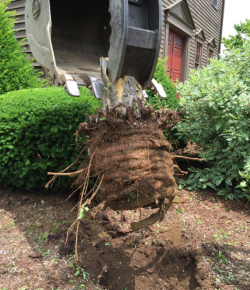 Preparing the Plant for Success. Life during production can be stressful on plants. Container grown plants have a limited rooting area within the pot, which commonly leads to circling roots. Circling roots need to be addressed at planting or they can lead to poor establishment and girdling, which can eventually lead to plant death. Methods for dealing with circling roots include cutting the root ball at intervals using pruners or a knife, separating roots by hand, or shaving the outside of the rootball.
Preparing the Plant for Success. Life during production can be stressful on plants. Container grown plants have a limited rooting area within the pot, which commonly leads to circling roots. Circling roots need to be addressed at planting or they can lead to poor establishment and girdling, which can eventually lead to plant death. Methods for dealing with circling roots include cutting the root ball at intervals using pruners or a knife, separating roots by hand, or shaving the outside of the rootball.
Balled and burlapped plants (B&B) also need attention at planting. All string or twine needs to be removed from the ball. All synthetic burlap needs to be removed and at least the upper half should be removed with natural burlap to ensure root growth isn’t inhibited. For larger plants that come with a wire basket, at least the top third of the basket should be removed.
Backfill. Backfilling is a very important part of the planting process. It is important when backfilling not to over-compact the soil. Heavy tamping, either with equipment or feet, can be very common but is not good for the plant. Heavy tamping removes all air pockets from the soil and, although large air pockets are undesirable, small pockets are needed. Light tamping is ok, but a better method for settling soil is to water thoroughly halfway through filling the hole and then again as the hole is completely filled. The hole should be backfilled with existing soil unless the soil is of very poor quality such as excessively sandy, heavy clay, or fill from new construction. If an entire planting bed is being created, performing a soil test and amending the bed with organic matter as recommended is a good practice.
Staking. Staking of trees should be as-needed, depending on the size and condition of the tree and the area that it is being planting. Large trees, trees not stable in the soil, or trees planted in windy areas need staking. Small trees generally don’t need to be staked if they are stable in the soil, since the movement or the trunk due to wind helps to create a stronger tree. Trees should generally remain staked for only 1-2 growing seasons (1 year). Not removing stakes in a timely manner can result in girdling of stems or branches or plant damage due to rubbing from the staking materials.
Maintenance
Good maintenance helps to ensure good establishment, which is the foundation for future plant health.
Mulch. Mulch is best applied in spring when the soil still has winter moisture. Mulch should be applied no more than 2-4” thick and should be kept away from the base of plants. When used appropriately, mulch reduces evaporation from the soil, adds organic matter to the soil (for organic mulches), acts like an insulator for plant roots (lessening the effects of fluctuating temperatures), and helps suppress weed growth. Mulch should not be piled up against plant crowns or tree bases because it can maintain moisture against the bark, leading to disease development, or can act as a home for rodents that may eat the bark or stem. Too thick a mulch layer can either stay too wet, leading to rot problems, or can prevent water from reaching the soil where it can be taken up by plants. Keep in mind that inorganic mulches such as stone or plastic don’t provide the same benefits to the soil or plants.
Watering. Adequate (but not excessive) water is essential for establishment and success of new plants. Plant water needs vary on a day to day basis and are influenced by soil type, plant size, weather conditions, and location in the landscape. The goal when watering plants is to make sure water is applied in the root zone of the plant (where it can be used by the plant) and that it is applied deeply – slowly soaking into the soil to at least the depth of the root ball. Shallow watering encourages root growth only at the soil surface, which does not allow for adequate establishment and will not be beneficial in times of water stress. Not sure if a plant needs to be watered? Feel the soil (and not just the soil surface). Keep in mind that rainfall may not be enough or consistent enough for good establishment and that supplemental irrigation may be needed through the first growing season. New plants need at least 1” of water every week for the entire first year.
Pruning. Many times plants are pruned to create a desired shape or to keep a plant a certain size. Plants can also be pruned to rejuvenate the plant and to thin out old, woody stems. Care needs to be taken when pruning plants to consider how plants will respond to the pruning. One common mistake is pruning at the wrong time of year. For flowering plants, when buds are set and when flowering occurs should determine when plants are pruned. The old adage “if it blooms before June, don’t prune” is a good starting point. Many plants that bloom in spring set flower buds the previous year in either summer or fall. If a plant such as forsythia or lilac is pruned in fall or early spring, there is a good likelihood that it will not flower because buds will be removed. Plants that bloom in summer and fall generally set buds in spring of the same year.
Another consideration when pruning is the impact it will have on light exposure throughout the canopy. Plants that are pruned to be wider at the top will result in reduced light penetration to lower parts of the plant. This will reduce plant growth in the lower part of the plant. Plants should be pruned so that they are wider at the base, allowing for better sun exposure.
Renewal pruning can be done to improve the look of older or overgrown shrubs. Over a course of a few years, up to one-third of the oldest, largest stems should be removed to the ground. This will encourage growth of new stems. This will be repeated until there are no longer overgrown stems.
Wrapping evergreens in winter. Use of burlap barriers can help protect evergreens from winter damage. The barrier should be constructed about two feet from the drip line of the plants, especially on the south and west sides or the sides exposed to wind. The top should be left open to allow light and air penetration. Individual plants should not be tightly wrapped as this can trap moisture and increase disease potential. Barriers should be removed in spring as the weather warms.
Sources:
https://static.colostate.edu/client-files/csfs/pdfs/633.pdf
https://ag.umass.edu/landscape/fact-sheets/guidelines-for-planting-trees-shrubs
Amanda Bayer, Extension Assistant Professor of Sustainable Landscape Horticulture, University of Massachusetts Amherst
News for Gardeners
What can I do to protect my flowering dogwood (Cornus florida) from dogwood anthracnose?
Dogwood anthracnose is a serious disease of flowering dogwood caused by the non-native fungal pathogen Discula destructiva. Symptoms include leaf spots and blotches, shoot blight and perennial stem cankers that disfigure or kill landscape trees. Infections by D. destructiva often result in a proliferation of epicormic shoots (also known as water sprouts) from main scaffold branches or the main trunk, reducing the aesthetics of the tree. Flowering dogwood (C. florida) and Pacific dogwood (C. nutalli) are highly susceptible, while Kousa dogwood (C. kousa) is highly resistant. Additional dogwoods common in landscape settings, such as red twig (C. sericea), corneliancherry (C. mas), pagoda (C. alternifolia) and Tartarian (C. alba), exhibit strong resistance as well.
The first and most important factor to consider when managing dogwood anthracnose is the location of the tree. Flowering dogwood should be planted in full sun settings only. Disease severity is inversely related to the amount of sunlight the tree receives; therefore, as shade exposure increases, so does disease severity. If an established tree resides in deep shade, the odds of effective management without aggressive chemical treatment can be low. Second, prune to increase sunlight and air flow throughout the canopy, especially in the lower canopy where shade and moisture can linger. Third, dead shoots and stems that develop in the canopy as a result of infection should be regularly pruned to reduce inoculum. The fungus overwinters within cankers on blighted stems and branches and, by removing these dead plant parts, we can improve the appearance of the tree and reduce the physical presence of the pathogen. Fourth, avoid needless stress and injuries that weaken a tree’s natural defenses. Create a large mulch ring around the tree to help the roots retain moisture and to limit contact with mowers and string trimmers. Injuries to the trunk can invite secondary pests like the dogwood borer.
If fungicides will be used, we must first weigh the cost of treatment with the likelihood of success. Fungicides should not be used alone, but in combination with the cultural management techniques described above. Fungicides applied during the spring when shoots and foliage are developing will help protect these sensitive plant parts. Many anthracnose fungi are most active in the spring during wet and mild weather, only to go dormant during the mid-summer period when conditions are warmer and drier.
Nicholas J. Brazee, UMass Extension Plant Pathologist
Trouble Maker of the Month
Invasive Oriental Bittersweet, Celastrus orbiculatus
Oriental bittersweet, Celastrus orbiculatus, is an invasive, deciduous vine found throughout New England. It is native to Korea, China and Japan, but was introduced into the U.S. around 1860 as an ornamental vine.
This woody perennial reproduces sexually by seed and asexually by creeping roots that sprout to form new stems. Oriental bittersweet can be observed growing as a brushy groundcover to a height of a few feet or as a climbing vine on tall trees where the vines may reach 40 to 60 feet with a diameter of 3 to 4 inches. Trees and shrubs are often killed by the climbing vines.
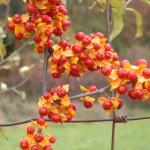 The stems of bittersweet are light or medium brown, with noticeable light horizontal marks; roots are bright orange. Alternate leaves are round with crenate margins. Inconspicuous, five-petaled, greenish-white flowers grow in clusters and are produced axillary along the stem. Flowering occurs in late spring and early summer. Oriental Bittersweet is almost always dioecious, producing male (staminate) and female (pistillate) flowers on separate plants. This can be readily observed in the fall as the female plants will be laden with fruit while male plants are fruitless. Individual fruits are about 1/3", globoid-ovoid in shape, and glabrous. At maturity, the outer husk of each fruit turns yellow and splits open into 3 parts to reveal a bright red, fleshy fruit that contains 1-2 seeds. For more images of Oriental bittersweet, visit the UMass Extension Weed Herbarium website.
The stems of bittersweet are light or medium brown, with noticeable light horizontal marks; roots are bright orange. Alternate leaves are round with crenate margins. Inconspicuous, five-petaled, greenish-white flowers grow in clusters and are produced axillary along the stem. Flowering occurs in late spring and early summer. Oriental Bittersweet is almost always dioecious, producing male (staminate) and female (pistillate) flowers on separate plants. This can be readily observed in the fall as the female plants will be laden with fruit while male plants are fruitless. Individual fruits are about 1/3", globoid-ovoid in shape, and glabrous. At maturity, the outer husk of each fruit turns yellow and splits open into 3 parts to reveal a bright red, fleshy fruit that contains 1-2 seeds. For more images of Oriental bittersweet, visit the UMass Extension Weed Herbarium website.
Fruits are readily consumed by various birds and other small animals. Consumption of fruit by animals is known to aid in the spread of this invasive plant. Oriental bittersweet is rarely affected by insect pests and disease organisms, which allows populations to grow unchecked. Humans can play a role in the spread of this invasive when they decide unwisely to use it as an ornamental plant in landscaping or collect branches of the colorful fruits for ornamental purposes.
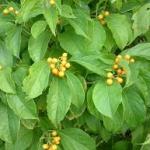 Very similar to Oriental bittersweet is our native American bittersweet (Celastrus scandens). American bittersweet has elliptical rather than rounded leaves, and the flowers and fruit of the female plants occur in a single clump at the tips of the stems (terminal) rather than spread along the stems (axillary). Male flowers of the native may occasionally occur along the stems. In areas where both species occur, it is possible for hybrids to develop. Pollen of these rare hybrids are reported to have low viability.
Very similar to Oriental bittersweet is our native American bittersweet (Celastrus scandens). American bittersweet has elliptical rather than rounded leaves, and the flowers and fruit of the female plants occur in a single clump at the tips of the stems (terminal) rather than spread along the stems (axillary). Male flowers of the native may occasionally occur along the stems. In areas where both species occur, it is possible for hybrids to develop. Pollen of these rare hybrids are reported to have low viability.
Management
Physical/Mechanical: Oriental bittersweet is a prolific seed producer and seedlings/small plants are very common. As part of an ongoing maintenance program, these seedlings/small plants should be pulled by hand as they appear. After Oriental bittersweet is controlled with herbicides, physical removal should be used as part of an ongoing management program to prevent regrowth.
Herbicides: Foliar applications of glyphosate will not control Oriental bittersweet. These applications will only cause temporary yellowing and the plant will recover in a short period of time. Foliar applications of triclopyr are a better postemergence choice. Both glyphosate and triclopyr can be used as a cut stem/cut stump treatment however. Selection of foliar versus cut stem/cut stump treatments will be determined by the growth habit (low-growing groundcover or tree-climbing vine) of the Oriental bittersweet. Triclopyr can also be applied a basal bark treatment.
Randy Prostak, UMass Extension Weed Specialist
Plant of the Month
Hydrangea macrophylla - “To Bloom, Or Not to Bloom… That is the Question”
May is the month when gardens really come alive with buds unfurling and color filling the landscape. After a cold winter and temperatures below zero degrees F. in many areas, and a very cold beginning to spring, it is a time not only to admire but to assess which plants are alive, just getting by, or just plain dead.
One plant that seems to pose a challenge to many gardeners, new and experienced alike, is Hydrangea macrophylla or Bigleaf hydrangea. Bigleaf hydrangeas are familiar to gardeners as the hydrangeas with the usually large round cluster (mophead) of blue flowers, or the flat cluster (lacecap) of blue flowers. The flowers also come in shades of pink and occasionally white. The plants are beloved by many, as they bloom in July-August and fill the landscape with their beautiful blue, pink, or white flowers….. sometimes.
We say “sometimes”, because Hydrangea macrophylla produces flower buds on the previous season’s growth (stems). The problem is that although Hydrangea macrophylla is winter hardy to zone 6 (-10 to 0 degrees F.), if the flower buds and/or the stems are exposed to below freezing temperatures, they may be, and often are, killed. Unfortunately, the flower buds may also be killed in a late season spring frost, or even in a warm winter, when unseasonably warm temperatures in February cause buds to start to open, only to be damaged or killed when temperatures fall below freezing again.
In many areas of Massachusetts, many Hydrangea macrophylla plants have not produced flowers for the two past years due to cold winters. This year, 2018, looks to be another year in many areas where many Hydrangea macrophylla plants will not bloom due to below zero degree temperatures.
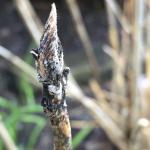
So, how to tell if your plants are damaged? Examine your Bigleaf hydrangeas and if the buds are plump and green and if the stems are not brittle and brown, then you may be in luck. However, if the buds look dry, tan and/or grey (Fig. 1) with no sign of green and if the brown stems snap easily (Fig. 2), then the plants may have been winter killed.
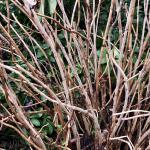
You may want to wait if you are unsure, and if there is no sign of life in the plants by the end of May, then prune back the dead material and new stems and flower buds will grow from the base (Fig. 3). These new stems will produce flower buds which should flower next year, if there is a mild winter and a mild spring and the buds are not killed by cold temperatures. There is an exception to this - if the hydrangea is a remontant type (see below), then new flowers will be produced this year on the new growing stems.
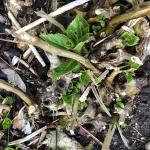
If you are tired of your Hydrangea macrophylla not producing flowers, then maybe it is time to take drastic action and pull the non-performing plants out and start over. Many of these plants are taking up prime locations in your garden and if all you get, year-after-year, are brown dead sticks and no flowers, well then, maybe it is time for a change.
There are bigleaf hydrangeas available that are more cold-tolerant and that will usually flower after a cold winter. There are also new cultivars that will produce flower buds on new stems as well as old stems, and these plants are referred to as remontant hydrangeas. Before buying a hydrangea, read about it, check the plant label and ask questions about the hardiness of the plant. There are so many bigleaf cultivars available now, making a wise-buying decision can be daunting.
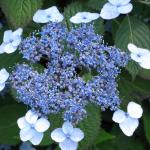 Some people have grown the lacecap flowering Hydrangea macrophylla ‘Blue Billow’ (Fig. 4) and it has flowered reliably for them after severe winter weather when other bigleaf hydrangeas have not. Dr. Michael A. Dirr, the renowned horticulturist and plantsman from Georgia has written a book on hydrangeas, Hydrangeas for American Gardens (Timber Press) and in it he has listed what he thinks are the best hydrangeas. He also made a list in his book Manual of Woody Landscape Plants (Stipes Publishing).
Some people have grown the lacecap flowering Hydrangea macrophylla ‘Blue Billow’ (Fig. 4) and it has flowered reliably for them after severe winter weather when other bigleaf hydrangeas have not. Dr. Michael A. Dirr, the renowned horticulturist and plantsman from Georgia has written a book on hydrangeas, Hydrangeas for American Gardens (Timber Press) and in it he has listed what he thinks are the best hydrangeas. He also made a list in his book Manual of Woody Landscape Plants (Stipes Publishing).
A few of the plants he recommends are:
- Hydrangea paniculata ‘All Summer Beauty’ - remontant
- Hydrangea macrophylla Endless Summer® - remontant
- Hydrangea macrophylla ‘David Ramsey’ - remontant
- Hydrangea macrophylla ‘Nikko Blue’
- Hydrangea macrophylla ‘Preziosa’
When planting Hydrangea macrophylla, try to select a non-windy, non- exposed location which offers morning sun and afternoon shade, in a well-drained, organic, moisture retentive soil.
An alternative to planting Hydrangea macrophylla would be to plant Hydrangea paniculata, or panicle hydrangea. These hydrangeas have attractive white flowers that often age to a subdued pink. They are not the colorful blue or pink flowers of the bigleaf hydrangeas, but they do flower reliably every year. They are winter hardy to zone 3 (-40 to -30 degrees F.) and the flowers are produced on the current year’s growth (stems), so even if the stems from the previous year were to be damaged, killed, or pruned, the plant will produce new stems and new flower buds that will flower in the current year; a win-win situation.
There are numerous Hydrangea paniculata cultivars available, such as: ‘Grandiflora’; Limelight®; Little Lime®; ‘Little Lamb’; Pinky Winky®; ‘Pee Wee’; ‘Tardiva’; Bobo®
Besides incredible winter hardiness, Hydrangea paniculata has no significant insect or disease problems and is a durable and attractive landscape plant. It prefers growing in full sun to light partial shade, in a well-drained, moisture-retentive, organic soil.
Hydrangea is a wonderful genus with many plants available for us to select and grow in our gardens. They offer color, flowers and structure for the summer garden, and often, well into fall.
Deborah C. Swanson, Horticulturist
Additional Resources
Landscape Message - for detailed timely reports on growing conditions and pest activity
Home Lawn and Garden Resources
Find us on Facebook! www.facebook.com/UMassExtLandscape/
Follow us on Twitter for daily gardening tips and sunrise/sunset times. twitter.com/UMassGardenClip
Diagnostic Services
The UMass Extension Plant Diagnostic Lab provides, for a fee, woody plant and turf disease analysis, woody plant and turf insect identification, turfgrass identification, weed identification, and offers a report of pest management strategies that are research based, economically sound and environmentally appropriate for the situation. Accurate diagnosis for a turf or landscape problem can often eliminate or reduce the need for pesticide use. Sampling procedures, detailed submission instructions and a list of fees.
The UMass Soil and Plant Nutrient Testing Laboratory at the University of Massachusetts Amherst provides test results and recommendations that lead to the wise and economical use of soils and soil amendments. The Routine Soil Analysis fits the needs of most home gardeners. Sampling procedures plus the different tests offered and a list of fees.
Spread the Word!
Share this newsletter with a friend! New readers can subscribe to our Home Gardener E-Mail List.
